#1 NW Front Street
Coupeville, Washington
Glenwood Hotel / Calhoun / McPherson's
1989 to 1890 - The Glenwood Hotel was built.
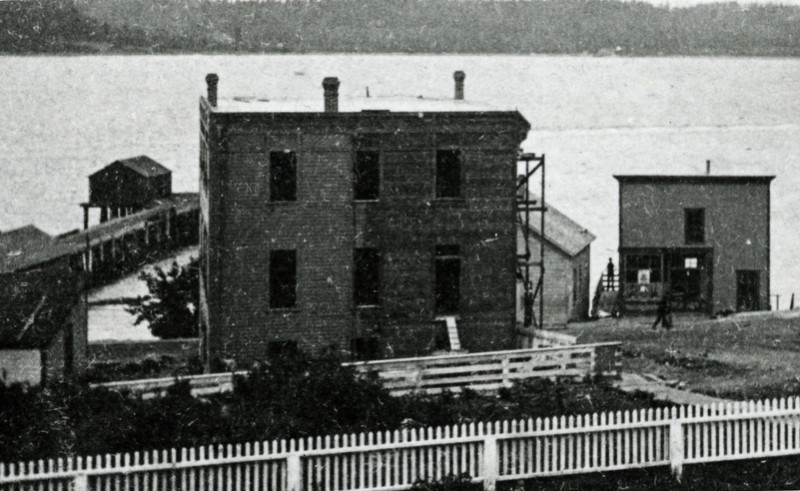
Glenwood Hotel during construction in 1890
Courtesy: Historic Whidbey
Quote from "How Coupeville Grew"
This elegant Italianate structure with tall bays and a balcony was probably the grandest building on Front Street and featured prominently in early photos. "A three-story structure with prominent window bays. Noted for fine baths, open to the general public."
Quote from "A Particular Friend, PENN'S COVE" by Jimmie Jean Cook
GLENWOOD HOTEL
After recovering from the injury dealt by the Commissioners in widening Main Street to sixty feet (and right through his picket fence), John Robertson entered into an agreement with Chris Fisher to construct a building to be used as a hotel. The building was to be 34' x 50' on the ground, said building to be built in as short a time as possible in reason.
For this Fisher would advance him $1000 to be used in the construction of the building and to be credited for rent at the rate of $50 per month, until it was used. Robertson leased the building to Fisher for a term of five years from the date of its completion.
In 1891 Fisher got a liquor license for the hotel.
On April 27, 1894, Robertson sold the building to Thomas W. Calhoun for $4000 less taxes due for 1892 and 93. On June 29, 1895, it was sold by Tom and Mary Calhoun to their son, Elmer Emmett Calhoun, who owned it until his death in 1969.
Elmer went north during the gold rush and worked in the mines. He didn't make a fortune but he did not go broke either. His brother, Spurgeon, wrote, "On April 6 or 7, 1897, I got a call at school from the Tacoma dock--'Your father and brother are here at the dock and would like to see you.' It didn't take me long to get there.
They were on their way. Three dogs and a ton of provisions were on a freighter headed for Die on the opposite side of the channel from Skagway, which was the landing point from where they headed over the hump to Lake Bennett. Here they spent a month to make their scow to go down the river. I think this trip is some 1500 miles.
All this freight may seem erroneous (one ton). Yet it put them on their feet because provisions in the Yukon were short and they traded half of it for an interest in a claim on Hunkers Creek that soon sold.
Father came home the next summer, 1898, and Elmer stayed. Not finding anything worth while there, he went up the Koyakuk about a thousand miles to Cold Foot and spent about ten years, coming home several times for supplies. He came home to the Alaska-Yukon Exposition in 1909, made one more trip later with no results and called it a job.
During his absence, Elmer leased the hotel to Charles Hoyt who was proprietor during a stormy time. The justice court records show that he was found guilty of disturbing the peace at the hotel on Sunday --fined $10. On June 9, 1904 he was found guilty of selling liquor to an Indian--fined $25. On March 21, 1905, he was found guilty of selling liquor on Sunday --asked for a change of venue and got it.
On November 13, 1905, he was found guilty of selling or giving liquor to an Indian. It would seem that one Charlie Snaklin also known as Long Charlie came into the Hotel and asked for a beer but said he had no money. Hoyt poured him a beer.
Sheriff Comstock came in while Charlie was drinking it and asked what it was. Charlie told him. Hoyt was fined $25 and Long Charlie was paid a $2.60 witness fee.
Elmer returned to rent out rooms in the hotel which was called Calhoun Towers unofficially, and to run the wharf. The lower part of the building has been used for several businesses, including the sale of giant clam shells.
Elmer served as the mayor of Coupeville and was one of its finest citizens. He was willing to give both his time and his property to make the community a better place to live in.
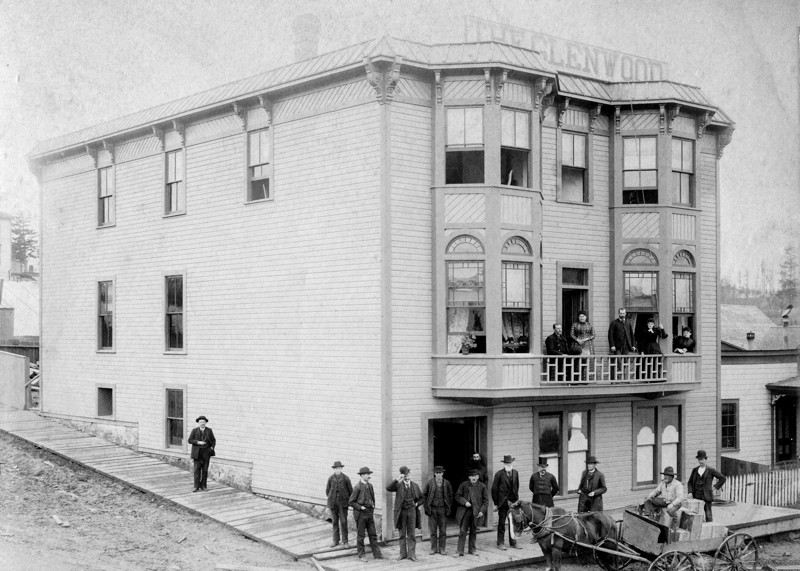
Glenwood Hotel
On the balcony are Mr. and Mrs. Edgecomb, Chris and Sibbel Fisher, proprieters, and Nellie Morse Dyer. Joe Goodwin is in the doorway. Courtesy: Island County Historical Museum, Coupeville
1894 - Thomas Calhoun bought the Glenwood and named it the Calhoun Apartments. The Calhouns [he was mayor at the time] bought and ran the hotel with 11 rooms and 3 apartments. The establishment was called the Calhoun Apartments or Calhoun Towers in 1894 and remained so until 1969.
1900 - Mansard roof added.
*Interview by Judy Lynn with James Arnold, 2009:
Judy: Would you tell the story of your family member being taken home by his horse?
Jim: Years ago the Butler and Burr Tavern was in the lower level of the Glenwood Hotel (now McPherson's.) Warner Alianson Arnold's grandfather (Bert's father) would get on his horse after a night of drinking and the horse would know the way back home to San de Fuca.
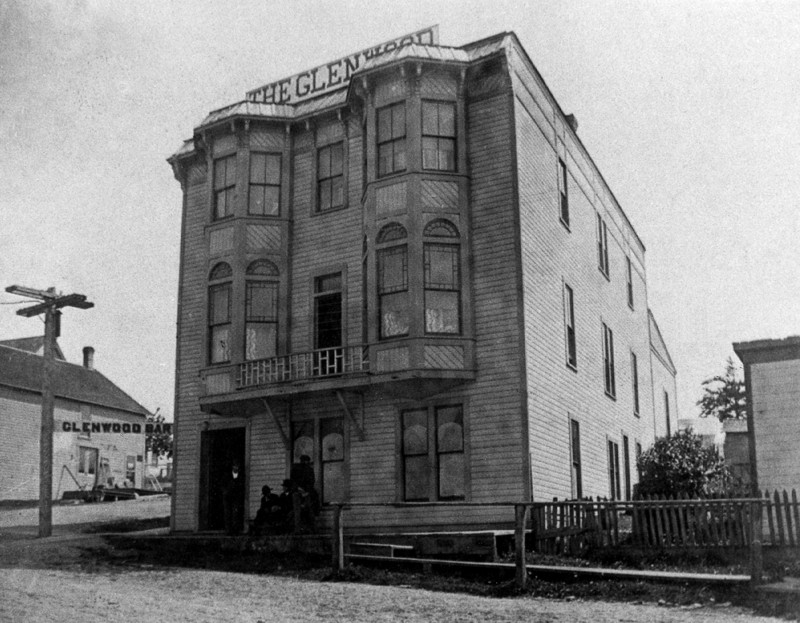
Glenwood Hotel, 1906
Courtesy: Island County Historical Museum, Coupeville
late 1930s - Fort Casey Dry Cleaners opened.
*Interview by Judy Lynn with Ilah Engom, 2009:
Judy: Tell me about your connection to Front Street.
Ilah: I had a dry cleaning shop in the downstairs of the Calhoun Building [Glenwood Hotel - now McPherson's]. I was 19.
Judy: Tell me how you got in the dry cleaning business.
Ilah: I was going to school in Seattle at the Edison Vocational School. Then I worked at Port Townsend Dry Cleaning doing alterations. My boss was in charge of alterations. He decided to start a dry cleaning shop in Coupeville. He did most of the alterations of soldier's uniforms and others who lived at Fort Casey. He started that business in a house near Prairie Center, in a two-story house near the rock. I don't know who the house belonged to or if it's still there. He ended up moving the business downtown into the Calhoun Building. He got a itchy foot and wanted to leave so he sold it to me for $1. My father went with me to Seattle to arrange the purchase. I took over payments of the equipment. I knew what to do. My mother helped with the pressing and the wives of some soldiers helped. Opal Sloth (Boyer) had graduated from high school and was single at the time and she did the alterations. I had three girls working for me. John Eelkema did the delivery for a time for me to Fort Casey. I had a young high school boy working for me, also delivering when John quit. I went at 7:30 in the morning and sometimes worked until 9:00 pm.
Judy: Describe the business layout.
Ilah: It took up the whole bottom floor. The front part was the office. The pressing equipment was also up front and the cleaning equipment was in the back. The alternations were behind the desk. We had a small fitting room with a mirror.
Judy: What was the name of the business?
Ilah: Fort Casey Dry Cleaners. The owner's name was Bill Lockart I believe.
Judy: How long did you have the business?
Ilah: I sold it in fall of 1943 or 1944 because I was pregnant and I couldn't do it. I was too sick. My mother was running it for me part of the time. Mr. Goldie, from Mount Vernon bought it and he moved it to Oak Harbor on Midway. He changed the name.
My folks lived in a house across from the original parsonage on 9th Street and I lived with them. I was going to be married soon and I told Elmer Calhoun I needed an apartment in his building. There were three apartments on the 3rd floor of the building and all shared a bathroom. I rented it for $25 a month. There were two apartments in the front and mine was in the back. The kitchen was in the very back. You had to go down a hall to get to the kitchen from a tiny living room and bedroom. The bathroom was in the hall and shared by all. We lived there until Lorraine Loddy left for Chicago, then we got a front apartment. The living room faced the water and the bedroom was behind that. The kitchen was near the back steps. Each apartment had it's own kitchen. Ours was the only one separated from the rest of the apartment.
1940s - Dick Coates sold radios. Top floor was hotel until 1940s then became apartments.
*Interview by Judy Lynn with Leone Argent, 2009:
What is now the McPherson building [Glenwood Hotel] Mr. and Mrs. Calhoun lived in it. I saw Mr. Calhoun once in awhile when I was at Herman Wanamaker's on their farm. He and his wife would visit. They were very quiet people. They didn't run it as a hotel.
Mr Calhoun owned the dock. I remember going out on the dock, it was harvest time and the doors were wide open. The Shermans, the Engles and the Hancocks would bring their wagonloads of grain in sacks and it would fill the dock. If you were going to Seattle on the boat, the guys would be putting the sacks of grain on to haul it to Seattle.
*Interview by Judy Lynn with Ilah Engom, 2009:
In the Calhoun [Glenwood Hotel] building Elmer Calhoun had apartments upstairs. I had one school teacher that lived there—Mrs. Fargo. She had beautiful blonde hair. I think she was married to a soldier at Fort Casey. I delivered eggs to her at her apartment. My parents raised some chickens and sold the extra eggs. Elmer was a quite unassuming little man.
I remember going to the movies at the theater. I remember two movies: The Hunchback of Notre Dame, and another that had a dog—a big German Shepard. You could hear the dog jangle the chain and someone would be killed. It scared me.
1941 - Ilah Lindsay [Engom] bought Fort Casey Dry Cleaners. She rented an apt upstairs from Elmer Calhoun
In 1943/1944. Ilah sold the cleaners to Mr. Goldie. He later moved it to Oak Harbor.
1958 - Fred Moore's lumber store. [Bill Engle started there in 1958 until fire in 1961.]
*Interview by Judy Lynn with Mike Sullivan, 2009:
Judy: Do you remember Fred Moore who had the hardware store in the bottom of the McPherson (Glenwood Hotel) building?
Mike: Yes. We used to go smelt fishing at "The Springs" about half way between Long Point and Coupeville. There was a spring and at high tide the smelt ran. We got permission from Fred Moore to walk down his driveway, "Moore Place." He would laugh and talk with us.
*Interview by Judy Lynn with Pat Sullivan, 2009:
I remember Elmer Calhoun. He was an old man then but he was always out there to improve the property. He didn't get much done but was always out there trying. I remember Bill Engle working for Fred Moore, owner of the hardware store in the Calhoun Apartment [Glenwood Hotel] building.
...
Chris Fisher built the Glenwood Hotel when he was 25 years old. Then he met and married Sibbel Barrington. They didn't want to raise kids in the hotel so sold to the Thomas Calhoun. They moved to San de Fuca and took over the San de Fuca store. They later moved to a farm in Crescent Harbor. He died there and she moved back to San de Fuca.
*Interview by Judy Lynn with Ed Youderian, fireman, 2010:
Judy: What about any other fires on Front Street?
Ed: The Calhoun building [Glenwood Hotel]. There was no power that night and no lights. The fire started in the [Fred Moore] hardware store. When we got there, there was smoke coming under the eaves of the building. I don't know how we lucked out. The building was built with balloon framing - the studs went straight up, from the bottom to the top, with the floor joists nailed to them. There were no firebreaks in the walls. It was like a funnel up through the walls. All the old buildings were built like that because they had such long lumber.
Judy: There were lots of combustibles too in the hardware store. It's a miracle it didn't burn to the ground.
Ed: Yes, and nobody was hurt. The damage was contained to the bottom floor. There were places the fireman opened up through the building. There was hot smoke in all of those rooms but there was enough water to create steam that sucked out the oxygen.
When we were all done we loaded up our hoses and Thelma Howard, who owned the liquor store down the street brought us a fifth of whiskey and said, "I think you boys need this". She was such a quiet person. She kept track of us there.
Judy: I had a tour of the building just last week by Joan and Jack McPherson and I could see evidence of the fire. In a few rooms there are black marks near the ceiling. The McPherson's described the smell of smoke when they recently had the asbestos siding removed—all these years later.
Judy: How did you know about the fire?
Ed: There was no electricity. Everyone was notified by wives and telephones. I was fire chief. My wife, Karen, started calling everybody. Those gals did a lot during those times. We had limited alarm systems.
The Sheriff's office had basic alarm systems. Art Black would holler and get us going on the Plectron that some of us had in our homes.
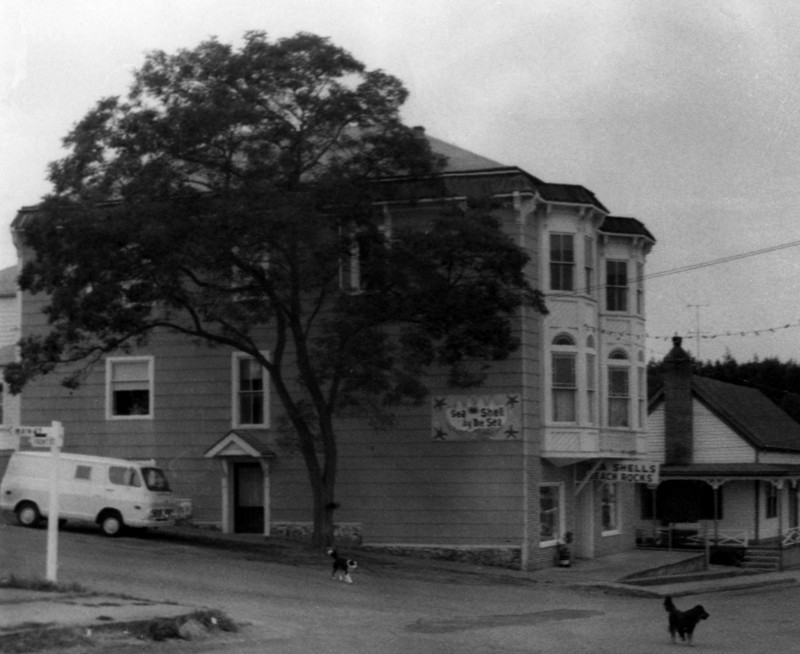
Calhoun Building, 1969.
Note the Shell Shop sign and the door has been moved to the center.
Courtesy: Island County Historical Museum, Coupeville
1970 - The building was auctioned. It was purchased by Jack and Joan McPherson
*Interview by Judy Lynn with Joan and Jack McPherson, 2010:
Judy: What brought you to Coupeville?
Jack: I was in the Navy and stationed in Seattle. A friend in the Navy suggested we see Fort Casey so we brought the kids up to fly kites. We visited Coupeville and the short story is - we never left.
Joan: It was 1969. We were having breakfast at the Sea Gull Restaurant on Front Street and I was sitting so I could see this building (the Glenwood Hotel). I was intrigued with it. It looked abandoned and uncared for. The shell shop, owned by Easton Mudgett, was in the bottom floor. We loved Coupeville and had been looking at houses with Sandy Roberts, a realtor. I asked him about this building. There was no "For Sale" sign. Sandy looked at me surprised and said "That's for sale." We looked at it and that was it. It was love at first sight.
Jack: I got an elbow in the ribs and heard, "Let's buy it." It has dominated our life ever since.
Judy: What did the building look like?
Joan: It had ugly gray asphalt siding all the way around and fake brick asphalt siding in the front. There were tattered shades and the paint was peeling. No niceties whatsoever, except for the two lovely oriel bay windows in the front. I remember when we bought it - when we finished things financially to do it—we took a Polaroid photo of it. We were so excited. On the way back to Seattle we stopped at a restaurant at the ferry landing on the Mukilteo side. We had the photo of building on the table, pouring over it, very excited. The waitress asked what we were excited about. When she looked at the photo she looked disappointed but she tried her best to act like it was halfway anything. Beauty is in the eye of the beholder.
The building was dismal inside and out. Anything that had been done was inappropriate to its age with no thought to history. Changes were done in the 40s and'50s. The plumbing was bad, the kitchen was awful and so was the wiring. The back yard side of the building had a very plain set of stairs up to back door. Another set of stairs in the back on the southwest corner was sunken. It was difficult to go up and down on them without falling off. The upstairs had been made into apartments. (Note: According to "How Coupeville Grew" Thomas Calhoun bought the Glenwood Hotel in 1894 and named it the Calhoun Apartments and later Calhoun Towers. He ran the business of 11 rooms….three apartments… until 1969.) It was when Fort Casey was active as a military installation. The addition on the south side was added in WW II when people from Fort Casey were living here. (Note: Ilah Lindsay Engom lived in one of the apartments on the upper floor in the early 1940s.) The fixtures and plumbing were probably from the '40s. There was Linoleum on the floors and counters. This addition contained a kitchen and was just a plain box and was attached to south side of the buidling. When we remodeled the kitchen in 1999, when they gutted it, a two foot wide gap had been created between this kitchen add-on and the original building. No wonder it was so cold inside! The construction workers (Jurgen Spatz's men) stuffed insulation into this gap and covered it up with siding that matched the original siding which is still here and is keeping us warm today.
This room [Note: we are sitting in a nook at the kitchen table] was a bedroom for a Chinese cook. At one time the building was used as a rooming house. We heard a Chinese cook lived in this tiny little room. He certainly had no room to move around, or do anything but sleep on a cot.
When we bought the building the rooms upstairs on the third floor had been "modernized" when they were made into apartments. Each apartment was two or three rooms—a bedroom, living room and kitchen. There was one bathroom that they all shared on the third floor. Most of the nice old molded woodwork was taken out and replaced by plain woodwork. The hallway and some doors still have original woodwork. There were bare light bulbs hanging on electrical cords in the rooms. The floor had a sub-floor and plywood over that. The rooms had Linoleum. Every room had an oil stove and pipes went directly through the walls, no insulation, to the three roof chimneys. It is a wonder the walls didn't catch fire.
Jack: I bet I took six old oil stoves out of this place.
Joan: The kerosene oil stoves were about three feet high. The renters carried oil and/or kerosene and filled them by hand. It is amazing that the building didn't burn.
We think that until World War I the building was used as a hotel. After World War I the hotel business died. Elmer Calhoun lived on the second floor. The relatives of Calhoun sold everything in the building after we purchased it, before we had possession, including the great old safe and a Morris chair, among many other things. The only thing unattached that we were left is an old U.S. flag.
Judy: I understand that Mr. Spurgeon Calhoun left a portion of his estate to the Island County Historical Society. Would you explain that?
Joan: The building was owned by brothers, Spurgeon and Elmer Calhoun. The building was for sale and listed with a realtor. Elmer willed his 1/2 portion to his heirs—a nephew and his wife in Seattle. Spurgeon gave his half to the Island County Historical Society. When it was sold to us, fifty percent went to the heirs of Elmer Calhoun and fifty percent to the Historical Society. There were heated negotiations between the two beneficiaries we didn't know about until after we bought it. Apparently it was a difficult situation. I'm glad we weren't a part of it.
I first met Inger Matthews when she was president of the Historical Society. She later became a good friend. She knocked on my door, introduced herself and the first thing she said was, "You have to get your oil tank off our property". The oil drum for this building was in the back yard. We didn't know anything about it. Apparently, as part of the negotiations, the Historical Society had received the old telephone building (at the corner of Coveland and Main Street). It originally was part of this property. When Elmer Calhoun modernized the building, the oil storage tank for the stove downstairs was in the backyard, next to Coveland Street. The oil stoves upstairs still had to be hand-fed.
When we first looked at the building the furnishings were plain. I remember a Morris chair in the living room by the oil stove. Before Elmer died he was living in the building on the second floor. When we first saw the building, it was like it was when Elmer was living in it. After Elmer's death, the nephew and his wife would come weekends. They put beds in the parlor.
In the parlor there was a bare bulb hanging from the ceiling with a string that tied it to the bedstead. The string pulled the light over the bed. There was a chain to turn it off and on. Again, it is amazing that jury-rigged electrical set-up didn't cause a fire.
[Note: There was a fire in 1961 in the hardware and building supply business owned by Fred and Elizabeth Moore on the street level. There is still evidence of the fire. The fire was allegedly caused by a spilled can of kerosene. The volunteer fire department saved the building. It was a storm night to add to the problems, the electricity to the town was out. See interview with Bill Engle for more details of the fire.]
When we met Elmer's heirs, the one thing they said was that they were mad at Elmer because after the fire Elmer wouldn't let them lower the ceilings of the building. I have loved Elmer for that, although I never knew him personally. It is strange, but even though this building was built as a hotel, it has always been a home. The owners have always lived in it from the beginning. I have never wanted to live anywhere else since the day I first saw Coupeville and the Glenwood Hotel. It has been over forty years. I love it.
[Joan and Jack gave Judy a tour of the house, including the attic. - Notes from the tour: The lower level with the entrance on Front Street had been used as a saloon, and a variety of businesses throughout the years. The McPherson's living space is entered from the back of the building. Because the building is on a hill, the ground level in the back becomes the second story on the front of the building. The second story is also accessed by a side door on the Main Street side and a staircase that leads to the parlor. This door was not in the original building, but was added later. The parlor is located on the Front Street side, upstairs. It contains the oriel bay windows. The parlor was the location for Joan McPherson's first law office. The ceiling height of the rooms on the bottom floor is 9 1/2 feet; the ceiling height of the rooms on the second floor is 12 feet; the ceiling height of the rooms on the third floor is 8 ½ feet.
An original staircase leads from the second story to the third. Being on the third floor is stepping back in time to when it was the Calhoun apartments. Much of the original woodwork, doorframes with transoms, wallpaper, flooring, and Linoleum are still in evidence. There are still room numbers on some of the doors. The rooms have a border of contrasting wallpaper along the top. The ceilings, as well as the walls, are wallpapered. There was effort made by Elmer Calhoun in the 1940s or '50s to "modernize" some of the rooms, and some of the intricate doors and doorframes were replaced. The McPherson's have upgraded a bedroom and bath on the upper floor. In another "apartment" one wall was removed. The rest are just as they were throughout the last century.
On the third floor, the McPherson's added an opening with a folding staircase for access to the attic. The attic is a large open space with large sturdy beams and wide plank flooring. This flooring originally was the flat roof of the building. This space was not actually attic space until a hip roof was added later on. It originally was the outdoors! Some of the planks run the full length of the floor. The hip roof was added onto the original flat roof. Most of the earliest photos of the Glenwood Hotel show the hip roof, although at least one photo was taken before the hip roof was added. It is assumed a 30' x 60' flat roof presented leaking problems in the rainy Pacific Northwest. It was decided early on to cover it with a hip roof to better handle rain and water drainage. There are many watermarks in the interior ceilings and walls which evidence many leaks over the years, whether from a flat roof or a hip roof. The latest leak happened in September of 2010! There has probably been a few more leaks since then.]
Judy: When did you move in?
Joan: We didn't move in permanently for a few years. I couldn't wait to move in, but I had no choice.
Jack: I was in the Navy and we were transferred to Oregon. Before that we came up on weekends.
Judy: Tell me about the occupants of the street level space.
Jack: When we bought it Easton Mudgett had his rock shop and he paid $30 per month. We raised the rent a little and he said he's moving out.
Judy: Before Mudgett a dry cleaning business, Fort Casey Dry Cleaning, was purchased by Ilah Lindsay Engam in 1941 and she ran it for two or three years. After that it was Moore's Hardware. Bill Engle worked for Fred Moore and believes Fred opened his hardware store in this building in 1955 or 1956. Bill worked for him beginning in 1958 until the fire, three years later. Then Mudgett had his rock shop. Then Shirley and Del Bennett opened the Penny Farthing Antiques on Memorial Day weekend in 1971. They ran it for two summers, and the third summer added a teashop.
Jack: No one had been living upstairs except for the Calhoun heirs. We came whenever we could and Joan and the kids stayed then. Joan's Aunt, Billie Thomas, lived here for a few years. She became a good friend of Holace (Perry) and Mickey (Becker) and Inger Matthews. She lived on this floor and had a bedroom upstairs on the third floor. She had her choice of bedrooms.
Judy: Tell me about your candy store.
Jack: I retired from the Navy in 1976 and I opened the candy store late that year. McPherson's Confectionery was open for ten years. Molly worked there beginning when she was seven years old. After we closed the candy store, it eventually became Joan's Law Office.
Joan: First it was a saloon for the hotel. There is nothing left of the saloon. It would be great to have something from the saloon but all remnants were long gone before we owned the building. (We are looking at the historical photo of the front of the building with people gathered around.) The door was on the left and after entering you went into the saloon on the right. Or you went up the stairs on the left to go up and register for the hotel. Later the door was moved to the center of the front and large windows were installed on either side.
Judy: I have also heard someone sold radios here.
Joan: Maybe in the hardware store. When we removed the asphalt siding the original wood siding was there and in good condition. There was still evidence of the fire of 1955. It took 40 years to get the asphalt siding removed. Jack would make each side of the building a project every few years and he would remove the asphalt siding, repair the original wood siding, and then paint it. This was 30 feet up and lots of siding. The final side, the east side, was finished in 2009. By then, we hired a contractor, Jurgen Spatz, to do most of the work. He did an excellent job.
We added the small uncovered porch in the back of the building in 1985. The larger veranda and covered porch in the back were added in 1999 when we had the kitchen remodeled. The southern exterior of the building was very plain and uninviting before that. The veranda posts are big old Victorian posts that I had lugged around for years, with no idea what they would be used for. The existing kitchen was truly awful and I used it for thirty years before we finally were able to remodel it. I found moldings and trim and other accessories and fixtures. The kitchen is now appropriate to its lineage.
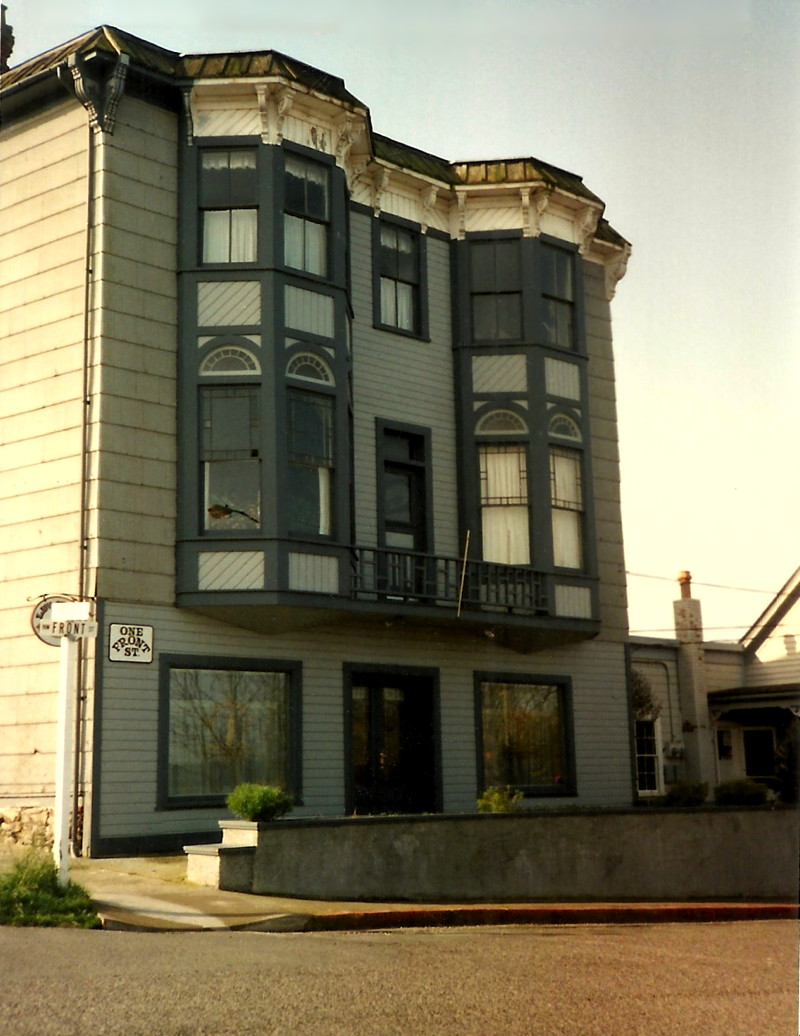
Calhoun Towers
Courtesy: Island County Historical Museum, Coupeville
1971 - Penny Farthing Antiques opened May 30, 1971. It was run by Del and Shirley Bennett in the summers.
*Interview by Judy Lynn with Shirley Bennett and Rose Brosseau, 2008:
That spring we came to Whidbey and I don't know why we thought of Front Street, Coupeville. Someone said "You need to see Mahlon Brosseau. He will know what's for rent." He was walking toward the Six Persimmons and I said, "I've been told to look you up." He told us that the McPherson's were planning on renting the main floor of their place [Glenwood Hotel]. They weren't there. They were someplace in the Navy. We went to Center Isle and the realtor showed us the 30 x 70 space that we could rent for $75 per month. We took it realizing we could come up and stay for the weekends. It was the perfect location. We met Betty and Jack [McPhee] and Holace [Perry] and Mickey [Becker]. We rented it in February, 1971 and opened the Penny Farthing Antiques Memorial Day weekend, May 30, 1971. We didn't have to do much but put in displays. We had a big packing box with Del's name and our Seattle address on it for the counter. We put a stool behind that and had a cash box. We built flat display tables and over time added more display shelves on the wall. We never did much. I hung muslin curtains so we could sleep in the back. We ran that store for two summers. The 3rd summer we put in the teashop to draw the antique browsers.
Candy Chromy and her sister, Diane Chromy [Eelkema], worked for us. Candy knew all about baking. We thought if we offered our customers something sweet to eat we would keep them there longer. Then we realized we had to have food. We had lunches - soups, salads, desserts - and we made jellies and jams with our scone specialties. We had a salad served in hollowed out oranges with fruit, split pea soup and Irish soda bread. We closed the antique shop in the fall of 1973 when the McPherson's wanted the space again.
1973 they added a tea room. It closed in Fall of 1973.
*Interview by Judy Lynn with Diane and Roger Eelkema, 2009:
I remember there being a shell shop in The Glenwood Hotel building run by Bill Pinkston.
Then Del and Shirley Bennett opened the Penny Farthing - antiques and tea room. They made tea in the English way and served scones. My sister, Candace Chromy, also worked there.
*Interview by Judy Lynn with Mickey Becker, 2008:
Mickey: The Bennett's had the Penny Farthing in McPherson's [Glenwood Hotel] building. They just came up on weekends. Their daughter Nikki wasn't too happy so she spent a lot of time in our shop and we enjoyed her.
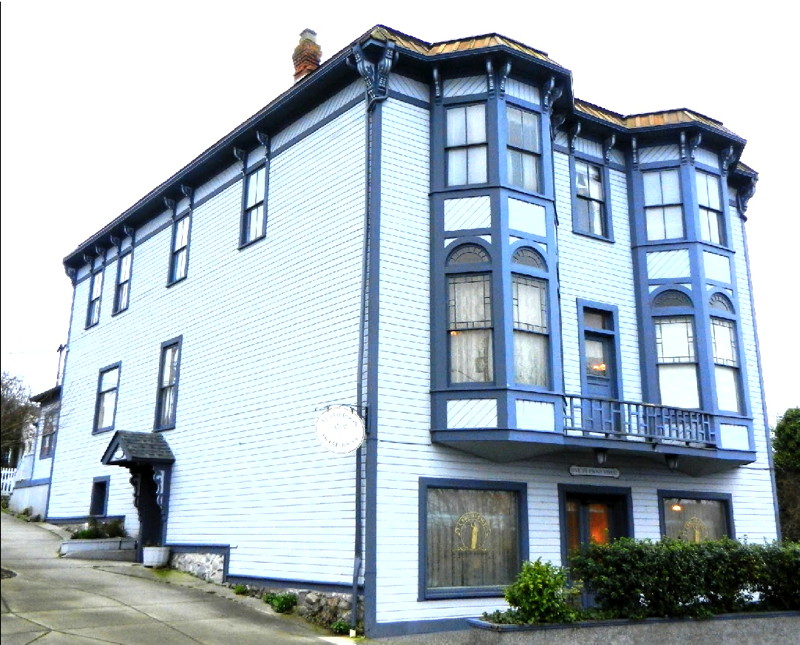
McPherson building
1976 - McPherson Confectionery opened by Jack McPherson
1982 - Barber shop opened by Ron Shelman?
1984 - The ground floor became the McPherson Law office
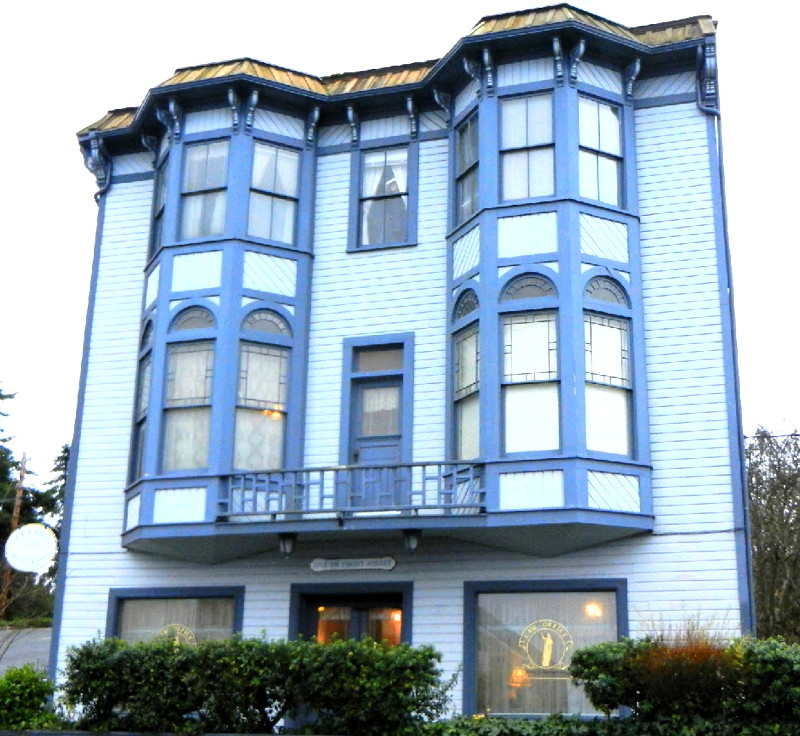
McPherson building
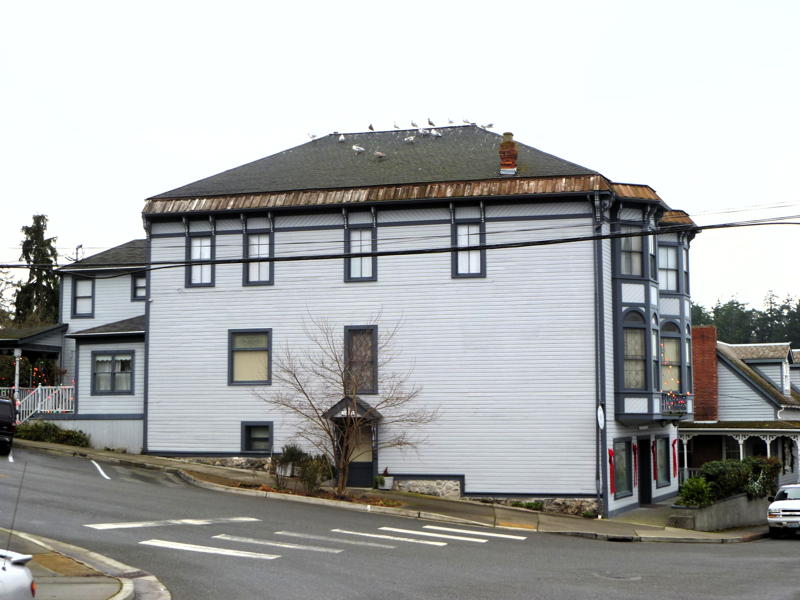
McPherson building at Christmas
Courtesy: Robert Y Elphick, 2013
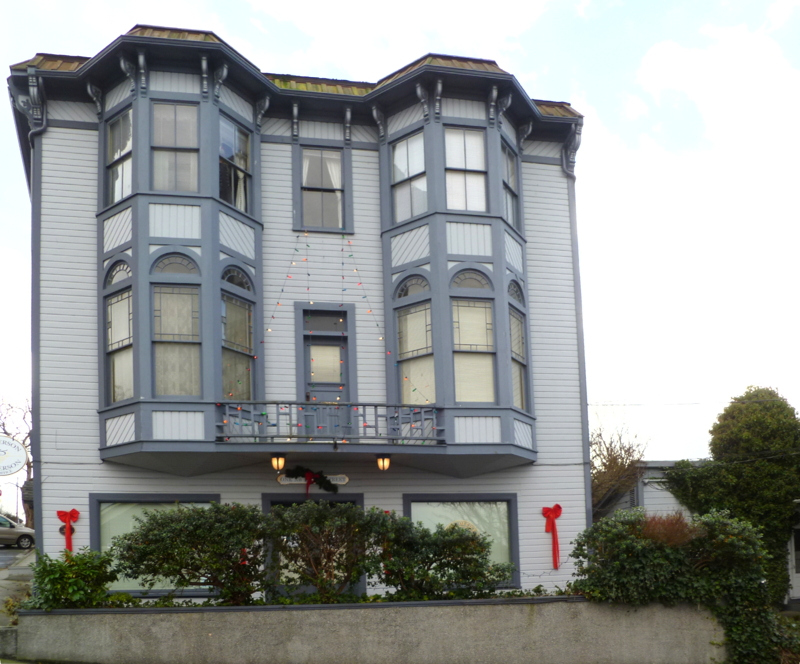
McPherson building
Courtesy: Robert Y Elphick, 2015
* All the interviews are extracted from the Judy Lynn's Oral History Project. Judy Lynn interviewed everyone she could find who had any memories of the history of Front Street. For more information on the project contact the Whidbey Island Historical Musem, Coupeville.
The e-book Front Street, Coupeville - An Oral History by Judy Lynn contains all the interviews. It can be purchased for $9.99 at Amazon.com for Kindle application or device or from the Apple Store for iBooks applications. Proceeds go to the Island County Historical Society.


